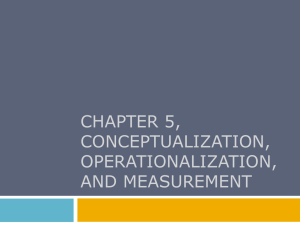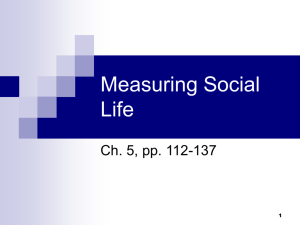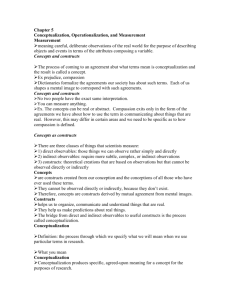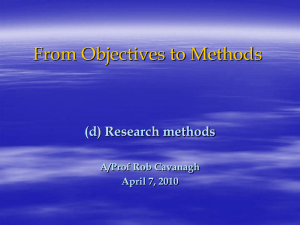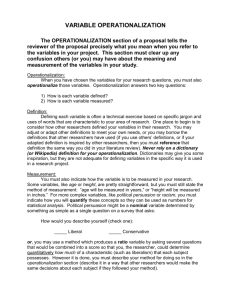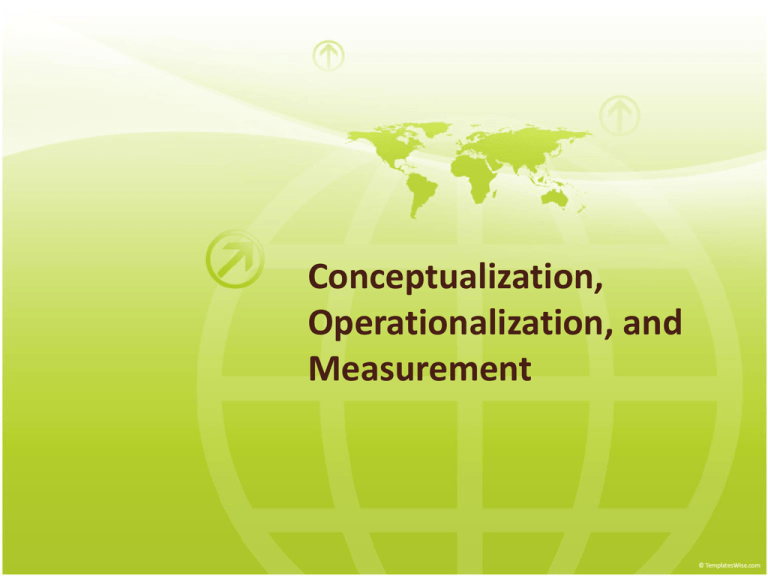
Conceptualization,
Operationalization, and
Measurement
Measuring
• « Satisfaction with College »
– How will you measure this concept?
Measurement:
-Careful, deliberate observation of the real
world for the purpose of describing
objects and events in terms of attributes
composing a variable.
Attributes are qualities or charateristics of
something
Variables are logical sets of attributes.
Measuring
• « Party affiliation »
– How will you measure this concept?
• Choices
– Look at voter lists of who is registered as a Republican or a
Democrat
– Ask people if they are with the Republicans or Democrats
‘Party affiliation’ by itself does not exist in the real world. These are
words that we have associated with certain facts that exist in the
real world. In other words « party affiliation » is a concept, when
we defiine the concept as « belonging to either the Republican
party or the Democratic party » we are doing
CONCEPTUALIZATION
Conceptualization
• We notice many things as we go through life
– We hear people say bad things about minorities
– We hear people say that women are inferior to men
– We also read that women make less than men for doing the
same work etc.
• These things exist in the real world. In order to describe
them we invent a word that describes such behavior by
people against people, and we call that word « prejudice »
This is the process of conceptualization. Converting the
mental images of what you observe in the real world into
a word or concept and then describing that concept
carefully in words.
Conceptualization
• How you conceive something as « prejudice » or as
« party affiliation » or as « religiosity » or as
« development » might be different to how I
conceive it, so how can we research a thing that
we both conceive differently?
– If we compare our menal images in the mental file
cabinet then maybe we can agree that if x, y and z are
present then we can agree that « prejudice » etc. exists
– The process of coming to an agreement on what terms
mean and then formally writing it down is called
conceptualization and the end result is a CONCEPT.
Meaning
• « In the big picture, language and communication
work only to the extent that you and I have
considerable overlap in the kind of enteries we have
in our mental file sheets . The similarites we have
represent that agreement exists in our
society…cultural factors shade our understanding of
concepts »
– Earl Babbie 2012:127
Foundations of ‘Scientific’
Language
• Note: In order not to talk past each other there
has to be shared understanding that is dependent
on cultural context and lived reality-Language is
rooted in societal structure- The language of
science tries to minimize this structural rooting of
its language to attain a higher level of ‘objectivity.’
– Conceptualization: is therefore the foundation of a
scientific language, without which everything else
is meaningless! Literally…
Measuring
• In order to measure « scientifically »
remember what we said in the beginning
lecture:
– You must have a thing to study that is real and
not imaginary.
In order to measure the « real » you rely on
your senses while being careful and deliberate
so as to guard against pitfalls, cultural and
logical.
Measuring
• « ABRAHAM KAPLAN »
– Three classes of things that sociologists measure:
1. Direct Observables (age, sex, height)
2. Indirect Observables (the force exerted, or the answer given)
3. Constructs (that measure either 1 or 2 since they have 1 or 2
as their ‘indicators’)
Constructs are based on mutually agreed mental conceptions of
some object or behavior, the conceptions must be based on
observables to be scientific.
Constructs do not have intrinsic meaning
The word « sex » means nothing in the real world, but by
associating it with some characteristics that are present in
some people and missing in others, (the INDICATORS of
« sex »)we designate « sex » based on observable
characteristics to be either male or female.
Measuring
• Sometimes you need to clarify the
« dimensions » of concepts:
– Compassion: feeling versus action dimension
– Religiosity: literary versus ritualistic dimension
etc.
Interchangebility of indicators
If we both disagree on what indicates <compassion> but
when we both use our own conceptualization of it to study
objects or behavior and come up with the same results then
we can talk of all dimensions of the concept leading to
similar directions of behavior, e.g. women being more
compassionate to men on various dimensions of
compassion etc.
Defining Concepts
• Real Definitions, that signify an « essential nature » of things are
problematic scientifically speaking, so we rely on
1. Nominal Defintions: arbitrary based on consensus on how
the concept will be used, it focuses our concerns for the
purpose of the study.
2. Operational Definitions: based on how the concept is actually
measured, e.g. SES- income and wealth
– The process through which we specify what a concept means
by definition is called SPECIFICATION, a form of conceptual
funnel passing through which your focus gets narrowed for the
purpose of your study
– Great researchers continually refine their concepts for more
objective application and clarity
Conceptualizing Anomie
« ANOMIE »: Without Law. Feelings of
meaninglessness.
Durkheim, 1897- Suicide
Merton, 1938- Social Structure and Anomie
Leo Srole (1956) scale- Anomia- the feelings of
meaninglessness in individuals: measured through agreedisagree questionnaire so that people could subjetively agree
or disagree with 5 statments.
An example of the process that describes how a concept is
measured, i.e OPERATIONALIZATION
Measuring
• « unemployment »
• « disability »
– How you define the concept will determine the
discription of the unemployed or the disabled,
BUT might not make explanatory results very
different if the definition is logical- as we saw in
the « interchangeability of indicators » segment
a few slides back.
.
Operationalization
• « Choices available for operationalization »
1. Range of Variation: e.g. income what is the highest category
you want. Should you measure the full range of variation or
not? Should be based on distribution in the population you
are studying.
2. Precision of variation: is it necessary to have three
categories between the highest and lowest or less?
Operationalization
3. « Levels of measurement » :
1.
2.
3.
4.
Nominal: merely differnt attributes don’t imply a logical rank ordering eg
Sex, Race
Ordinal: different attributes that can be rank ordered using some
dimension Class, Education etc.
Interval: different attribute that can be rank ordered and have equal
distance between adjacent attributes, e.g. 1-32* is the same as 33-64,
age ranking 17-18 same distance as that between 32-33
Ratio: different attributes, can be rank ordered and also based on true
zero value- e.g. gives greater detail than interval level data by being able
to measure the exact percentage difference between two intervals
however apart because there is a true ZERO.
4. Single or multiple indicators:
– GPA- college performance- one course or all?
Operationalization
Research Question: Are women more compassionate
than men?, how can you go about researching this
question?
Note: Qualitative research is more flexible in open ended
conceptualization and operationalization but end
results are equally « open » to interpretation, there is
often no falisfication that is inherent in hypothesis
testing with predetermined concepts as in most
quantitative analyses.
Measurement Quality
– Precision
Has to do with detail and depth.
Precise measures are generally superior to imprecise
ones but precision is nnot always necessary: Age: 43
or « in her 40s », which one is more precise?
Also, precision does not mean accuracy
-Accuracy:
The correctness of the measure.
-born in Illinois is less precise than born in
Carbondale, Il, but suppose the person was born in
Chicago, Il, then the less precise measure will be the
more accurate one.
Reliability and Validity
• Reliability:
– A particular technique applied to the same
object, does it produce the same result?
e.g. measuring morale at the factory
Qualitative approach: looking at behavioral cues
Quantitative approach: looking at grievances
filed in objective terms.
Which is more reliable and why?
Is reliable more accurate? Is reliable more
precise?
Techniques for Checking
Reliability of measures
• 1. Test-Retest Method:
– Comparing answers to the same questionnaire
administered at two different times
– Checking your qualitative observations in the same
setup at two different times then comparing your
notes
• 2. Split-Half method
• Split your measures into half and then test them
seperately to see if the results between the halves are
similar. E.g. ten items that measure prejudice, split them
into a group of two seperate 5 item measures, then
compare results between two.
Reliability and Validity
• 3. Using Established Measures:
– Measures that have been used in previous
studies (does not guarantee that they are either
accurate or precise)
4. Reliability of Research Worker
In qualitative do independant coding to
compare with your or someone else’s coding
In quantitative call-back respondents or revisit a
sample of records to ensure correct recording.
Validity
• Validity:
– The extent to which a particular measure
accurately reflects the underlying concept.
– Validity means that we are measuring what we
say we are measuring, e.g. measuring height for
« how tall is x? » rather than weight
Types of Validity
i) Face Validity: common understanding /images
of the concept, the measure should be logically
consistent with such understanding and images.
Reliability and Validity
ii) Criterion-related validity (or predictive
validity)
– The degree to which a measure can have predictive success, related
to some external criterion.
III) Construct Validity:
- The logical/theoretical relationship between variables. How is this
variable supposed to be related to other variables, e.g. poverty and
health, socioeconomic status and crime etc.
IV) Content Validity:
Does the measure the complete range of the concept, its various
dimensions e.g. militarization, how will you measure it?
.


